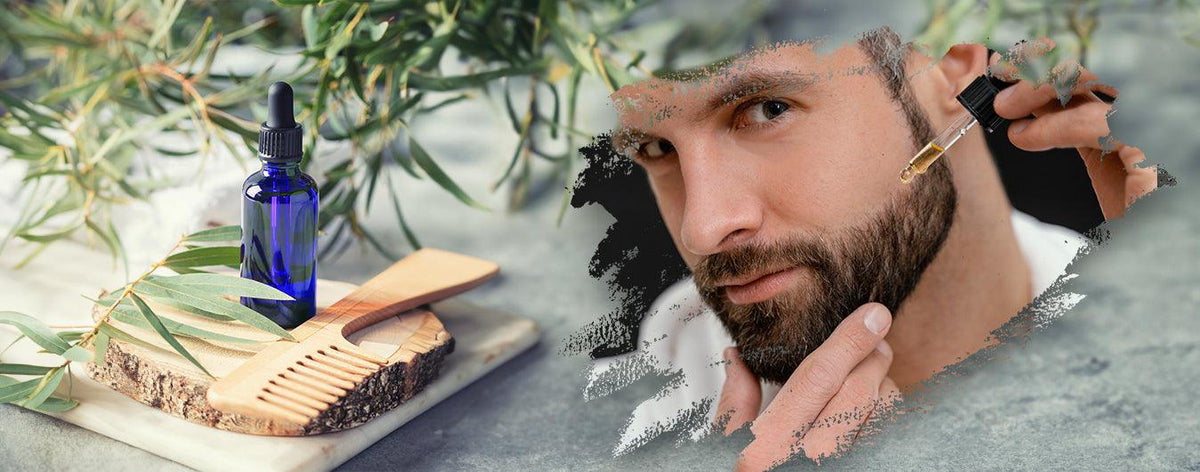প্রাকৃতিকভাবে দাড়ি বৃদ্ধির জন্য গাইড

দাড়ি ফ্যাশনের প্রবণতা বিকশিত হতে থাকে। এটি একজন ব্যক্তির ব্যক্তিত্ব সম্পর্কে অনেক কিছু বলতে পারে। একজন ব্যক্তির দাড়ির শৈলী তাদের ব্যক্তিত্ব এবং সৃজনশীলতা প্রতিফলিত করতে পারে। এটি স্বাস্থ্যকর, সম্পূর্ণ এবং ভালভাবে রক্ষণাবেক্ষণ করা উচিত। প্রাকৃতিকভাবে ঘন এবং সুস্বাদু দাড়ি বাড়াতে চান?
ডায়েট এবং লাইফস্টাইল পরিবর্তন থেকে এসেনশিয়াল অয়েল এবং নির্দিষ্ট গ্রুমিং অনুশীলন পর্যন্ত, এই নির্দেশিকা দাড়ি বৃদ্ধিকে উদ্দীপিত করার জন্য কার্যকর পদক্ষেপ প্রদান করবে এবং আপনাকে বুঝতে সাহায্য করবে যে কীভাবে মুখের চুলের সমস্যাগুলি সম্পূর্ণ দাড়ি বৃদ্ধিতে রূপান্তরিত হয় ।
দাড়ি বৃদ্ধি বোঝা

ছেলেদের বয়ঃসন্ধিকাল দাড়ি এবং গোঁফের মতো মুখের চুলের চেহারার সূচনা করে। কিছু কিশোর ছেলে এমনকি তাদের গোঁফ এবং দাড়ির চেহারা সম্পর্কে উদ্বিগ্ন হতে পারে।
একটি প্যাঁচানো দাড়ি অনেক পুরুষের জন্য হতাশার কারণ হতে পারে। প্যাচাল বৃদ্ধির কারণগুলি জেনেটিক্স থেকে হরমোনের ভারসাম্যহীনতা পর্যন্ত পরিবর্তিত হতে পারে। পুরুষ হরমোন, টেস্টোস্টেরন এবং ডাইহাইড্রোটেস্টোস্টেরনের নিম্ন মাত্রা মুখের চুলের বৃদ্ধি এবং পুরুত্বকে প্রভাবিত করে এবং দাড়িতে ফাঁক হতে পারে। জেনেটিক্সও একটি ভূমিকা পালন করে।
এটা বোঝা অপরিহার্য যে বিভিন্ন কারণ দাড়ি বৃদ্ধিকে প্রভাবিত করে। তবে প্রথমে, আসুন দাড়ি বৃদ্ধির বিভিন্ন ধাপগুলি দেখুন। মাথার ত্বকের চুলের বৃদ্ধির মতো দাড়ির চুলের বৃদ্ধি চক্রের মধ্যে ঘটে।
চুলের বৃদ্ধি ক্রমাগত ঘটে এবং চারটি পর্যায় দ্বারা চিহ্নিত করা হয়: অ্যানাজেন , বৃদ্ধি; ক্যাটাজেন , রিগ্রেশন; টেলোজেন , বিশ্রাম; এবং এক্সোজেন , শেডিং। স্বতন্ত্র চুলের ফলিকলগুলি স্বাধীনভাবে চক্রাকারে চলে, প্রত্যেকের জীবনে দশ থেকে ত্রিশটি চক্র হয়। (নিকোল নাতারেলি, 2023)
অ্যানাজেন ফেজ: এই পর্যায়ে, চুলের ফলিকলগুলি নতুন চুল তৈরি করে, সক্রিয় বৃদ্ধির পর্যায়। এই পর্যায়টি আপনার দাড়ির চুলের দৈর্ঘ্য নির্ধারণ করে এবং কয়েক বছর স্থায়ী হতে পারে।
ক্যাটাজেন ফেজ: এই ক্রান্তিকালীন পর্যায়ে, চুলের বৃদ্ধি ধীর হয়ে যায় এবং চুলের ফলিকল সঙ্কুচিত হয়। এই পর্যায়টি কয়েক সপ্তাহ স্থায়ী হয়।
টেলোজেন ফেজ: বিশ্রামের পর্যায় যেখানে চুল আর গজায় না।
এক্সোজেন ফেজ: এই পর্যায়ে চুল পড়ে যায় এবং চক্রটি আবার শুরু হয়।
জেনেটিক্স, বয়স, হরমোন (প্রাথমিকভাবে টেস্টোস্টেরন এবং ডাইহাইড্রোটেস্টোস্টেরন) এবং সামগ্রিক স্বাস্থ্য সহ বেশ কিছু কারণ দাড়ির চুলের বৃদ্ধিকে প্রভাবিত করতে পারে।
সর্বোত্তম বৃদ্ধি সমর্থন করতে, একটি স্বাস্থ্যকর জীবনধারা বজায় রাখুন, একটি সুষম খাদ্য খান, স্ট্রেস পরিচালনা করুন এবং চুল ও ত্বকের পুষ্টির জন্য দাড়ির তেল বা বালামের মতো পণ্য ব্যবহার করার কথা বিবেচনা করুন।
দাড়ি বৃদ্ধিকে প্রভাবিত করে এমন উপাদান

প্যাঁচানো দাড়ির মতো, একজন ব্যক্তির দাড়ি বৃদ্ধি প্রধানত জেনেটিক্স এবং হরমোন দ্বারা প্রভাবিত হয়। কিন্তু জীবনধারা এবং অভ্যাস দাড়ি বৃদ্ধিতেও প্রভাব ফেলতে পারে।
অন্যান্য অনেক কারণ দাড়ির বৃদ্ধিকে প্রভাবিত করতে পারে। স্ট্রেস, খারাপ খাদ্যাভ্যাস, ঘুমের অভাব এবং কিছু চিকিৎসা শর্ত দাড়ি বৃদ্ধিতে বাধা দিতে পারে। উচ্চ চাপের মাত্রা হরমোনের ভারসাম্য ব্যাহত করতে পারে, যার ফলে দাড়ির বৃদ্ধি ধীর হয়ে যায়। একইভাবে, অত্যাবশ্যকীয় পুষ্টির অভাবের খাদ্য একটি স্বাস্থ্যকর দাড়ি বৃদ্ধির জন্য প্রয়োজনীয় বিল্ডিং ব্লকগুলি থেকে বঞ্চিত করতে পারে। ঘুমের অভাব হরমোন উৎপাদন এবং দাড়ি বৃদ্ধির সম্ভাবনাকেও প্রভাবিত করতে পারে। উপরন্তু, থাইরয়েড রোগের মতো কিছু চিকিৎসা অবস্থা মুখের চুল সহ চুলের বৃদ্ধির হারকে প্রভাবিত করতে পারে।
আপনার দাড়ি বৃদ্ধিতে বাধা প্রদানকারী অন্তর্নিহিত সমস্যাগুলি সনাক্ত করার জন্য এই কারণগুলি বোঝা অত্যন্ত গুরুত্বপূর্ণ। এই বিষয়গুলিকে মোকাবেলা করা আপনার দাড়ির উন্নতির জন্য একটি অনুকূল পরিবেশ তৈরি করতে পারে।
দাড়ি বৃদ্ধির প্রাকৃতিক উপায়
এখানে, আমাদের দাড়ি বৃদ্ধি এবং এটিকে প্রভাবিত করার কারণগুলির একটি প্রাথমিক ধারণা রয়েছে। আসুন দাড়ির বৃদ্ধি বাড়ানোর কিছু প্রাকৃতিক উপায় অন্বেষণ করি।
এসেনশিয়াল অয়েল দিয়ে দাড়ির বৃদ্ধি বাড়ান

প্রয়োজনীয় তেলগুলি দীর্ঘকাল ধরে তাদের থেরাপিউটিক এবং ঔষধি বৈশিষ্ট্যগুলির জন্য ব্যবহৃত হয়ে আসছে। কিছু এসেনশিয়াল অয়েল দাড়ির বৃদ্ধির জন্য আশাব্যঞ্জক ফলাফল দেখিয়েছে।
দাড়ি বৃদ্ধির জন্য সবচেয়ে জনপ্রিয় অপরিহার্য তেলগুলির মধ্যে একটি হল রোজমেরি তেল। এটি DHT-এর প্রভাবগুলিকে অবরুদ্ধ করে চুলের বৃদ্ধিকে উৎসাহিত করে , এক ধরনের টেস্টোস্টেরন যা সাধারণত চুলের ফলিকল (মাথার ত্বক এবং দাড়ির চুল) সঙ্কুচিত করার জন্য দায়ী এবং চুলের ক্ষতি হতে পারে। (সুপেন ভারোথাই 1, 2014 জুলাই) রক্ত সঞ্চালন উন্নত করে, রোজমেরি এসেনশিয়াল অয়েল চুলের বৃদ্ধিকে উদ্দীপিত করে। (ডেভিস, 1988) এটি অ্যান্টি-মাইক্রোবিয়াল এবং অ্যান্টি-ইনফ্লেমেটরি এবং রক্ত সঞ্চালন বাড়ায়। (আলফ্রেডো রসি 1, 2016 জুলাই 18) এটি ক্লিনিক্যালি চুলের বৃদ্ধি বাড়াতে দেখা গেছে, যেমন মিনোক্সিডিল (একটি সুপরিচিত চুলের পুনর্গঠনের উপাদান)। (ইউনেস পানাহি, রোজমেরি তেল বনাম মিনোক্সিডিল 2%, 2015 জানুয়ারী-ফেব্রুয়ারি) ।
দাড়ি বৃদ্ধির সুবিধার জন্য পরিচিত আরেকটি অপরিহার্য তেল হল ল্যাভেন্ডার এসেনশিয়াল অয়েল। বৈজ্ঞানিক পরীক্ষায় বলা হয়েছে যে ল্যাভেন্ডার তেল অক্সিডাইজেশন এবং ত্বকের পুনর্গঠনকে বাধা দেয়, বিকাশকে প্রচার করে এবং প্রত্যাশিত চুলের বৃদ্ধি করে। (Boo Hyeong Lee MJ, 2016) এটি একটি কার্যকর হেয়ার টনিক (Sellar, 1992) এবং এক মাসে চুল পড়া কমাতে পারে এবং চার সপ্তাহের মধ্যে চুলের বৃদ্ধিকে উৎসাহিত করতে পারে। (ড. লুক্সিতা শর্মা, 2018) ।
দাড়ি বৃদ্ধির জন্য প্রয়োজনীয় তেল ব্যবহার করতে, ক্যারিয়ার তেলের সাথে কয়েক ফোঁটা মিশিয়ে দাড়ি এবং ত্বকে ম্যাসাজ করুন। এটি দাড়ির বৃদ্ধিকে উৎসাহিত করবে এবং মুখের চুলকে ময়েশ্চারাইজ করবে এবং কন্ডিশন করবে।
ত্বক এবং চুলে অপরিহার্য তেল ব্যবহার করার সময়, যেহেতু তারা ঘনীভূত উদ্ভিদ তেল, তাই সাবধানে তাদের পাতলা করতে ক্যারিয়ার তেল ব্যবহার করুন। এগুলি কখনই সরাসরি ত্বকে দেওয়া উচিত নয় কারণ অ্যালার্জির প্রতিক্রিয়া হতে পারে।